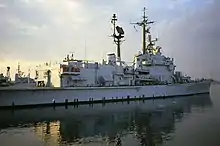Italian cruiser Caio Duilio
Caio Duilio (C 554) was an Andrea Doria-class helicopter cruiser of the Marina Militare. Built by Navalmeccanica at Castellammare di Stabia, it was named after the Roman consul Gaius Duilius.
 Caio Duilio in 1963 | |
| History | |
|---|---|
| Name: | Caio Duilio |
| Namesake: | Gaius Duilius |
| Builder: | Navalmeccanica , Castellammare di Stabia |
| Laid down: | 16 May 1958 |
| Launched: | 22 December 1962 |
| Commissioned: | 30 November 1964 |
| Decommissioned: | 15 November 1989 |
| Stricken: | 19 July 1991 |
| Fate: | Sold for scrap 31 December 1992 |
| General characteristics [1] | |
| Class and type: | Andrea Doria-class cruiser |
| Displacement: | 6,500 long tons (6,604 t) |
| Length: |
|
| Beam: | 17.3 m (56 ft 9 in) |
| Draught: | 5.0 m (16 ft 5 in) |
| Propulsion: | Steam turbines, 4 boilers, 2 shafts, 60,000 shp (45 MW) |
| Speed: | 30 knots (56 km/h; 35 mph) |
| Range: | 5,000 nmi (9,300 km) at 7 kn (13 km/h; 8.1 mph) |
| Complement: | 485 |
| Sensors and processing systems: | |
| Armament: |
|
| Aircraft carried: | 4 helicopters |
Design
The Andrea Doria class was intended to provide long range anti-aircraft and anti submarine protection, and as such was armed with a single Mark 10 twin rail launcher for the American Terrier surface-to-air missile forward and a large helicopter deck and hangar at the aft end of the ship.[1] It was planned to carry three Sea King helicopters, but these proved too large for the ship, and four Agusta-Bell AB-212 helicopters were carried instead.[1][4]
Close-in anti-aircraft protection was provided by eight 76mm/L62 Allargato rapid fire guns mounted on pedestals around the ship's superstructure, while two sets of triple torpedo tubes for lightweight anti-submarine torpedoes provided short range anti-submarine armament.[1][2]
History
The ship was laid down on 16 May 1958, was launched on 22 December 1962, and commissioned on 30 November 1964.[1]
The ship was assigned to the 2° Gruppo Navale d’Altura (2nd High Seas Naval Group) of the II Divisione Navale (2nd Naval Division), based in Taranto. In the 1980s she was transferred to La Spezia, while her sister, Andrea Doria, moved from there to Taranto.
During the late 1970s, Caio Duilio was upgraded to carry the improved SM-1ER Standard missile, with improved radars and sonar also being fitted.[5][1]

In 1979–1980, Caio Duilio was converted to a training cruiser to replace the old Capitani Romani-class cruiser San Giorgio. The ship's original hangar was turned into classrooms and additional accommodation, with a new, smaller, hangar being built on the forward part on the helicopter deck, reducing the ship's aviation capacity to two helicopters. The aft two 76 mm guns were also removed, together with their associated fire control radars.[5][2]
Caio Duilio was decommissioned on 15 December 1989, stricken on 19 July 1991 and sold for scrap on 31 December 1992.[6]
References
Citations
- Gardiner and Chumbley 1995, pp. 204–205.
- Layman and McLaughlin 1991, p. 148.
- Prézelin and Baker 1990, p. 274.
- Blackman 1971, p. 182.
- Prézelin and Baker 1990, p. 275.
- Baker 1998, p. 374.
Sources
- Baker, A.D. The Naval Institute Guide to Combat Fleets of the World 1998–1999. Annapolis, Maryland, USA: Naval Institute Press, 1998. ISBN 1-55750-111-4.
- Blackman, Raymond V. B. Jane's Fighting Ships 1971–72. London: Sampson Low, Marston & Company, 1971. ISBN 0 354 00096 9.
- Gardiner, Robert and Stephen Chumbley. Conway's All The World's Fighting Ships 1947–1995. Annapolis, Maryland USA: Naval Institute Press, 1995. ISBN 1-55750-132-7.
- Layman, R. D. and Stephen McLaughlin. The Hybrid Warship. London: Conway Maritime Press, 1991. ISBN 0 85177 555 1.
- Prézelin, Bernard and A.D Baker. The Naval Institute Guide to Combat Fleets of the World 1990/91. Annapolis, Maryland, USA: Naval Institute Press, 1990. ISBN 978-0-87021-250-5.